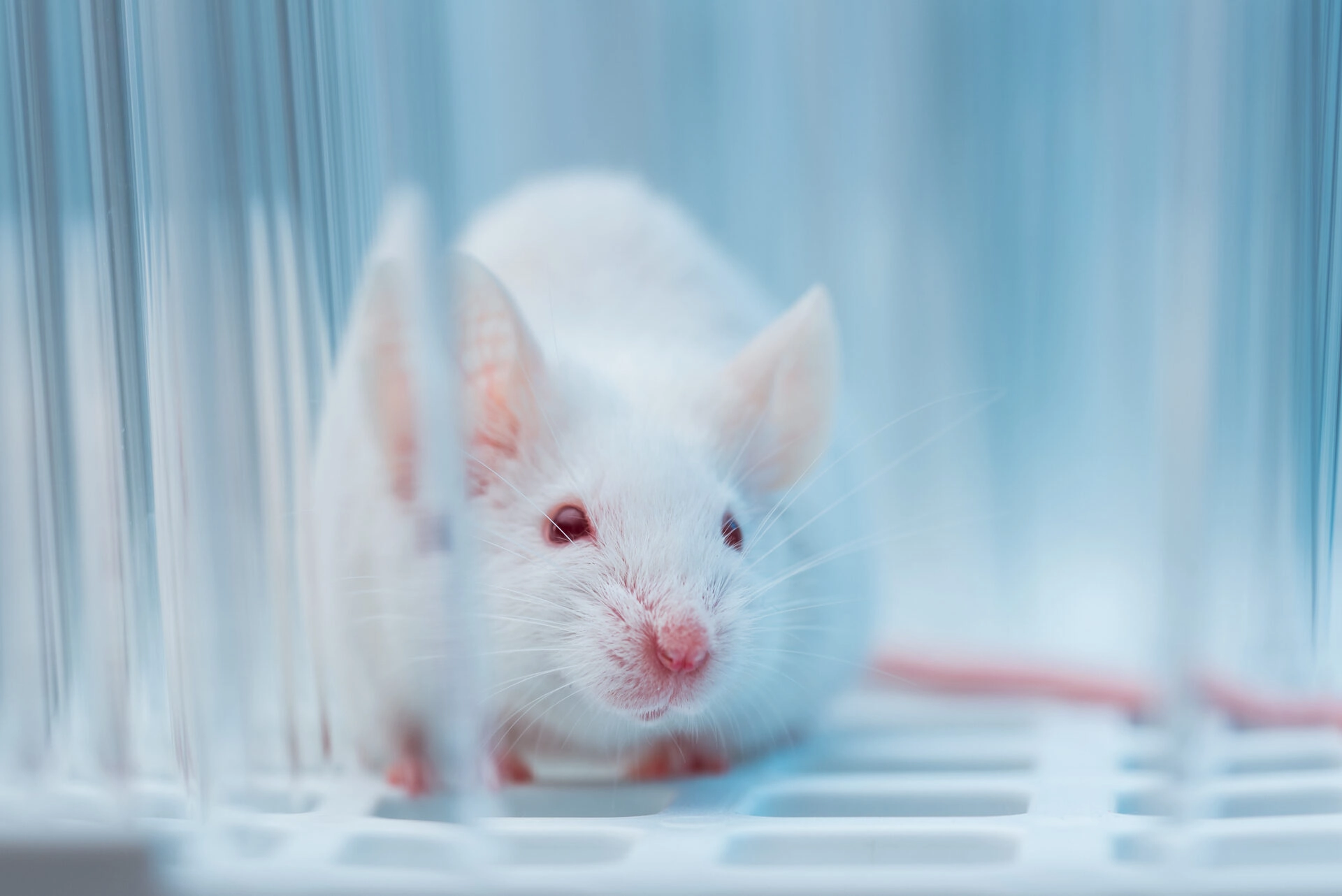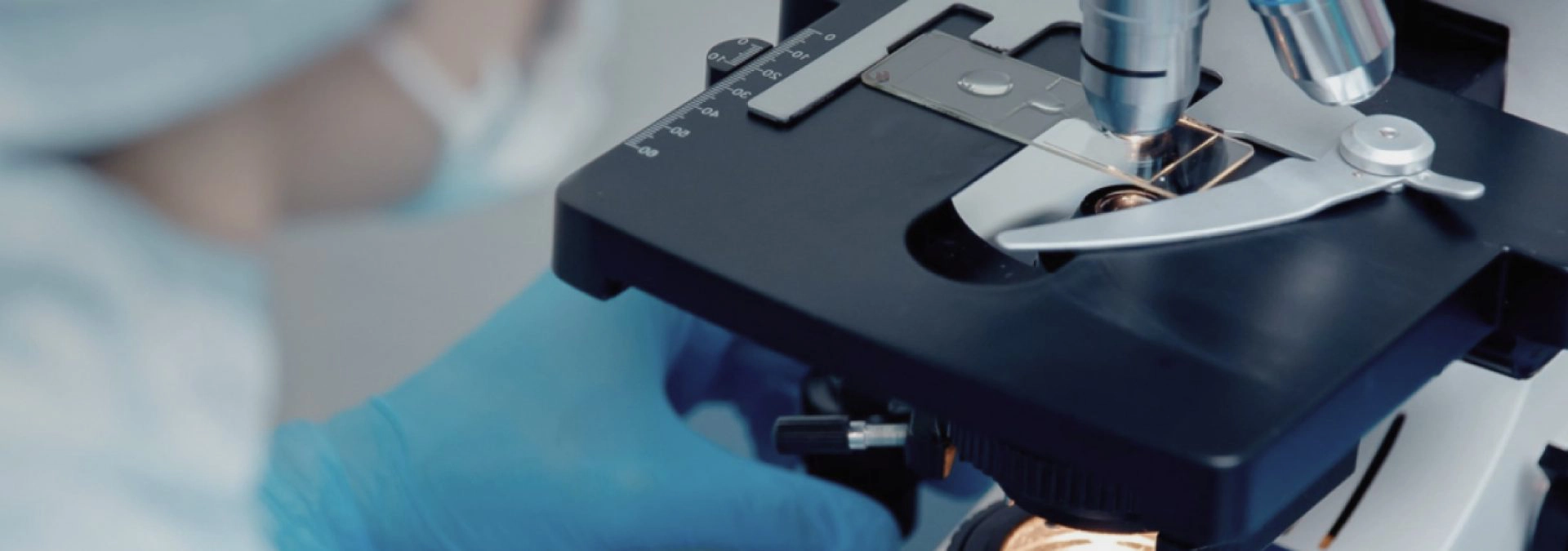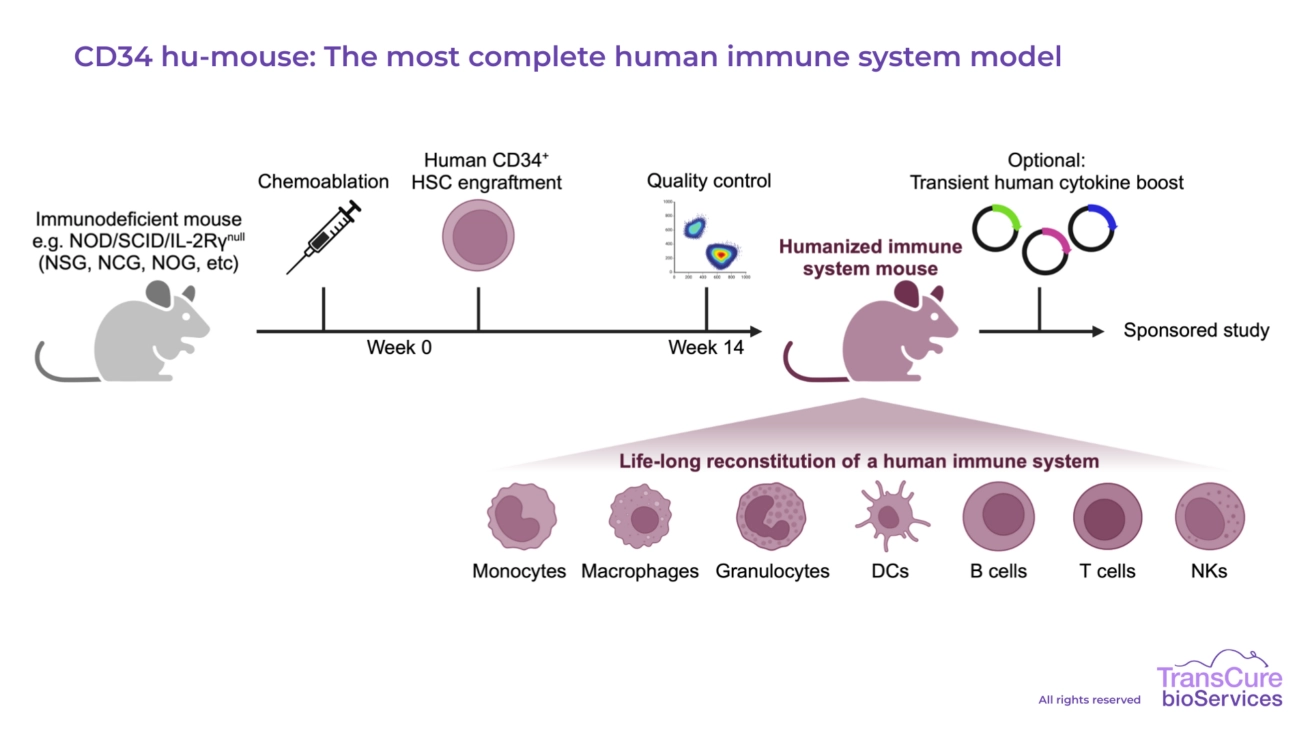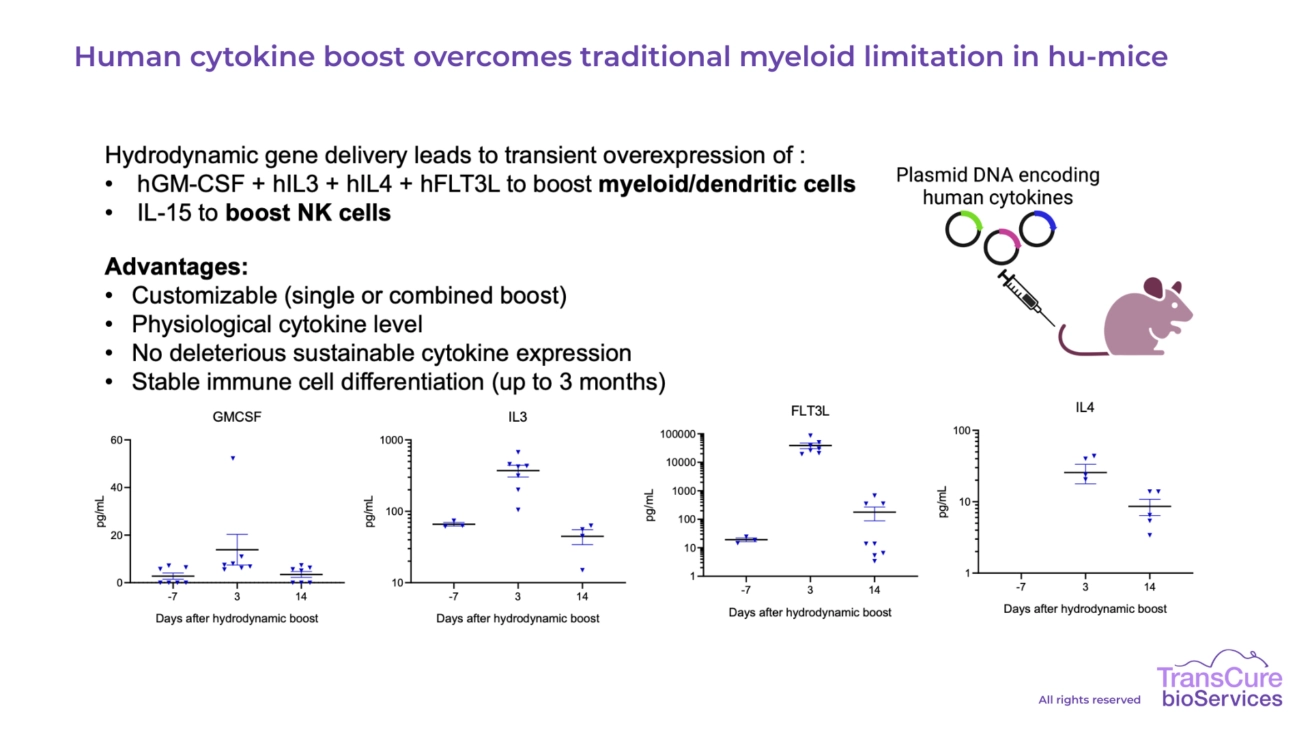
The immune system is central to the development and progression of numerous diseases, including cancer, inflammatory, and autoimmune disorders. As a result, a growing number of therapeutic candidates target immune pathways – highlighting the urgent need for reliable and predictive preclinical models to evaluate their efficacy and safety.
To address this, TransCure bioServices has developed a highly translational humanized mouse model featuring a functional human immune system. Highly immunodeficient mice are engrafted with CD34+ hematopoietic stem cells (HSC) purified from human umbilical cord blood, leading to the reconstitution of complete human hematopoiesis, providing a powerful platform for the in vivo assessment of human-specific immunotherapies.
Main characteristics
-
Fully Functional human Immune System
By 14 weeks post-engraftment, CD34+ humanized mice develop a robust and functional human immune system, comprising a diverse range of immune cell populations, including CD4+ and CD8+ T cells, regulatory T cells (Tregs), γδ T cells, B cells, monocytes, macrophages, NK cells, plasmacytoid and myeloid dendritic cells (pDC, mDC), and neutrophils. This comprehensive immune reconstitution enables highly relevant studies of human immune responses in vivo.
-
Life Long Stability
Unlike PBMC-engrafted mice, CD34+ humanized mice maintain a full spectrum of immune cell populations for up to one year, with a very low incidence of GvHD. This allows for long-term studies with stable and functional human immunity in vivo.
-
Improved Heath
Our humanization protocol relies on chemoablation using busulfan, avoiding irradiation, which is known to induce progressive anemia over time. Additionally, we use high-purity, in-house purified CD34+ hematopoietic stem cells, which significantly reduce the risk of GvHD and contribute to consistent and long-term immune reconstitution.
-
Improved Reconstitution of Innate Immunity
To achieve a more balanced and representative differentiation of dendritic cells, myeloid cells, and NK cells, we have developed an optimized boosting protocol that enhances these populations without overstimulating the T cell compartment. This is accomplished through hydrodynamic injection of plasmids encoding key human cytokines—IL-3, IL-4, IL-15, GM-CSF, and FLT3L—promoting targeted immune lineage expansion while preserving immune system homeostasis.
-
High Degree of Human Immune Cell Reconstitution
With over 12 years of experience, we have continuously refined our protocols to optimize both the engraftment success rate and the level of humanization. On average, our models achieve greater than 50% human CD45+ cells (hCD45/total CD45), ensuring robust and reliable human immune system reconstitution for preclinical studies.
-
No Waiting Time
There’s no need to wait 14 weeks to start your study or worry about the logistics of humanizing animals—we take care of that for you. Thanks to our weekly production of CD34+ humanized mice, we maintain a rolling stock to ensure short lead times and immediate availability, so your project can begin without delay.
Applications
Uncover disease areas for your humanized mouse studies
-
Human CDX
Test your candidate's anti-tumor activity on established human cancer cell lines in immune-humanized mice to decipher the contribution of a fully functional human immune system.
See the disease model -
Human PDX
Assess drug efficacy on patient-derived tumors engrafted into humanized mice, preserving tumor heterogeneity and clinical relevance.
See the disease model -
Immunotoxicity
Screen for immune effects of your compound in the context of a fully reconstituted human immune system.
See the disease model -
IBD
Explore inflammatory bowel disease mechanisms and validate immunomodulatory compounds targeting human immune cells.
See the disease model -
MASH
Study the progression of metabolic-associated steatohepatitis and evaluate therapeutic candidates in a human liver context and/or in the presence of a fully functional human immune system.
See the disease model -
GvHD
Preclinical model of graft-versus-host disease in immunodeficient animals engrafted with human PBMC.
See the disease model -
Lung inflammation
Assess respiratory inflammation and immune-mediated lung disorders using Humanized Immune System mouse model.
See the disease model -
HIV
Investigate HIV pathogenesis and assess anti-retroviral treatments in mice reconstituted with human immune cells.
See the disease model -
HBV
Model hepatitis B virus infection in vivo using human liver-engrafted mice to evaluate anti-viral compound and/or liver cell targeted therapies.
See the disease model
Contact us to have more information
Contact usKnow everything about the CD34+ humanized mouse
-
How do you generate humanized mice?
Humanized mice are generated by engraftment of CD34+ haematopoietic stem cells from human cord blood in immunodeficient mouse strain after a chemoablation treatment. No irradition is performed to avoid anemia and therefore get more robust and stable humanized mice. -
What type of mouse strain can be humanized?
We can humanize many different mouse strains, all have in common to be highly immunodeficient mouse models: NCG, NOG, NOG-EXL … Our team can guide you on the best model to select based on your mechanism of Action. Please note that humanized NCG are prepared in advance to speed up the process. -
What is the advantage of the boost by comparison to transgenic mouse models?
The hydrodynamic boost allows the transient expression of human cytokines, that will support the development and proliferation of immune populations. By comparison to transgenic mouse models that constitutively express human cytokines, no deleterious effects on the mice is observed after the boost. In addition, the hydrodynamic boost technique is fully adaptable. -
What is the number of mice that can be humanized with one CD34+ cord blood donor?
From one CD34+ human cord blood donor, an average of 30-50 mice can be humanized. Larger cohorts can be humanized based on specific requests. -
Is it possible to screen CD34+ donors or use donors with specific haplotypes?
Yes, it is possible, the CD34+ donors could be screened for specific haplotype. -
Can you engraft mobilized CD34+ HSC from patient with a genetic mutation?
Yes, this is feasible - we have experience with the engraftment of mobilized hematopoietic stem cells (HSCs). However, it’s important to note that mobilized HSCs typically result in lower levels of humanization compared to cord blood–derived CD34+ cells, which remain the gold standard for robust and consistent immune reconstitution. -
Do you have male and female humanized mice?
Our rolling stock is based on female NCG mice, which consistently yield optimal humanization levels. However, we can provide custom humanization of male mice upon request. It’s important to note that male humanization typically results in lower engraftment efficiency, and therefore may lead to reduced levels of human immune cell reconstitution compared to females.
You have more questions?
If you have further questions or would like to discuss how our humanized mouse model can be tailored to your specific research needs, our scientific team is here to help. We’re committed to providing clear, responsive support and working closely with you to design studies that align with your objectives. Don’t hesitate to reach out - we’re always happy to share our 12 years of expertise and explore solutions together.
Contact us


